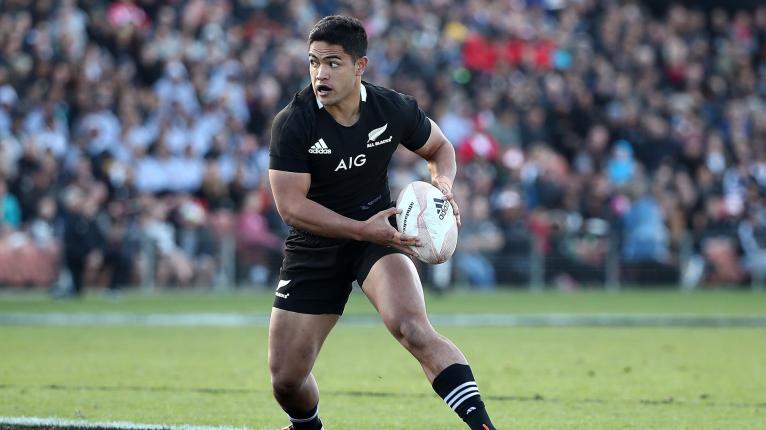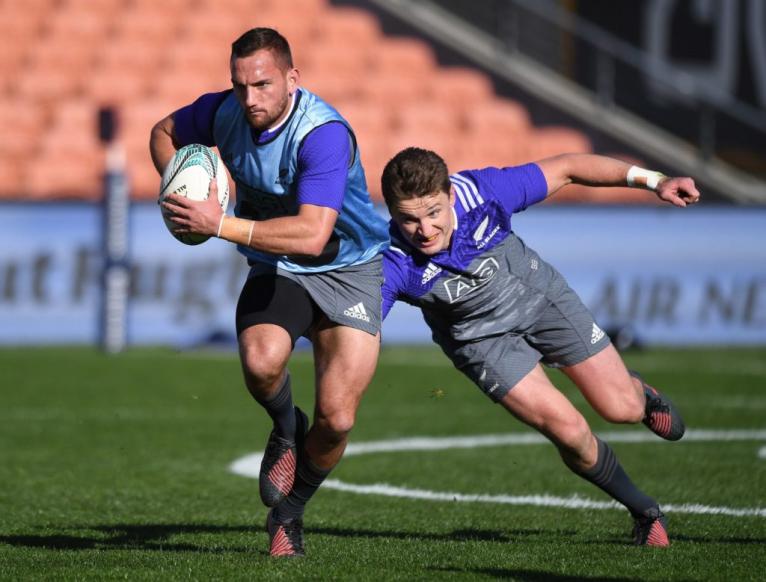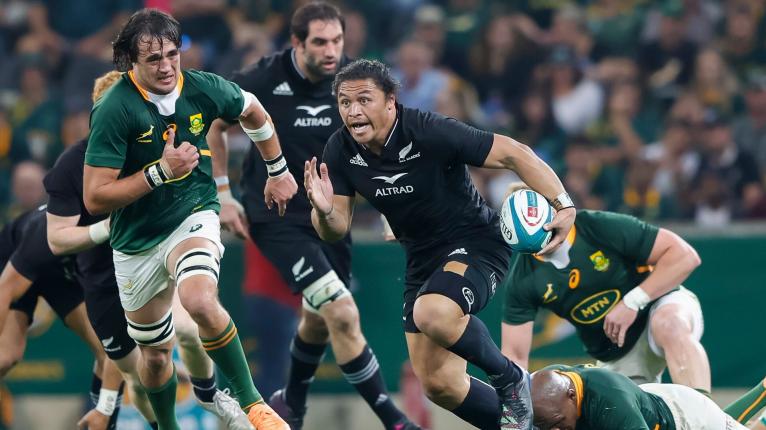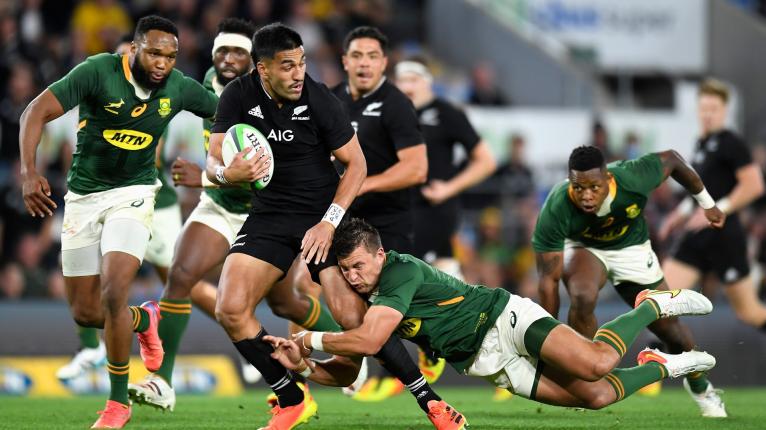There’s no doubt that, two years ago, it did seem like the battle of the ages was going to begin between Beauden Barrett and Richie Mo’unga to be the All Blacks‘ playmaking king.
The old master was still in top form, but the young apprentice was pushing him hard and with their different body shapes, and different skill sets, the All Blacks were relishing what these two might be able to do for the attack game.
But here we are now, two years since this likely battle was hyped to high heaven, and it hasn’t materialised. Some will say the elevation of Mo’unga to start at Ellis Park in the second test against South Africa – a move which saw Barrett demoted to the bench – is proof this battle is real and alive.
But the real story there is that selection is an illustration of a head coach trying to save his job. There’s been no epic contest and the All Blacks, from beginning this World Cup cycle with two of the best No 10s in the world, now have two players who haven’t kicked on and who would be lucky to be classed in the top echelon of playmakers at the current period in time.
Make no mistake, however, Barrett and Mo’unga are the only two No 10s in the country that are capable of playing Test rugby. It’s not just that they haven’t kicked on, no one has – and if one or both of these two were struck down in the next few weeks, the All Blacks would be in even greater trouble than they are now.

Of the emerging generation, neither of Stephen Perofeta nor Josh Ioane look ready yet to command a test. How New Zealand has ended up with no fizz or depth at No 10 is in stark contrast to what happened a decade ago.
It was a faintly embarrassing situation 10 years ago that New Zealand could magic up world class fly-halves from some seemingly endless conveyor belt of talent.
Back in 2011, they had Daniel Carter, arguably the greatest of them all, and literally nobody else. He was the only guy in the country that could stick the All Blacks No 10 shirt on and do the role justice and of course, New Zealand discovered this at the World Cup when he was injured out of the tournament before the last pool game.
The All Blacks somehow scrambled to victory but that was really because of the sheer determination of Jerome Kaino and Richie McCaw and the brilliance of the All Blacks back three – Israel Dagg, Cory Jane and Richard Kahui – in catching high balls.
When Steve Hansen took over as head coach in 2012, he knew he had to find some new talent at No 10. Carter was 31, increasingly injury-prone and the All Blacks couldn’t expect to fulfil their ambition to be the most dominant team in the world if they had just one, ageing, albeit brilliant No 10 in their midst.
Even when Carter was fit, he was not quite the automatic selection of old and the pressure he was under to deliver continued to keep him hungry and driven to succeed.
Hansen brought in Aaron Cruden and Beauden Barrett. The plan was to slowly build the game time of both – but particularly Cruden who had matured and developed since making his test debut in 2010.
Fate was cruel to Carter in that period in that he suffered an endless run of horror injuries and rarely did he even manage to play consecutive Tests. Carter’s misfortune, however, was Cruden’s gain and he earned enough game time to reach the end of 2013 as a genuine challenger.
By then, even when Carter was fit, he was not quite the automatic selection of old and the pressure he was under to deliver continued to keep him hungry and driven to succeed.
That pressure ensured that Carter’s skill set had to continue to grow because not only was Cruden breathing down his neck but Barrett, by 2014, was starting to show what he could do in the No 10 jersey as well and so from starting the cycle with one genuine No 10, the All Blacks had three in seemingly no time.
Even more incredible was that they probably had five men who were genuine test players as both Colin Slade and Tom Taylor started Tests in that period such was the injury crises at times.
The strategy in building this depth of talent was relatively simple: Hansen backed his veteran No 10 but always gave one of the younger 10s, mostly Cruden, game-time off the bench and starts against lesser teams to stake their claim.

It wasn’t equal opportunity, but it was opportunity all the same, and the next generation were able to use their cameo appearances to put pressure on the established, senior players and it built genuine competition for places.
More than that, it forced everyone to keep developing their respective game and to respond to the pressure they were being put under. As current All Blacks coach Ian Foster, who was in charge of the backs in 2012, said in Steve Hansen: The Legacy: “That was an intense process looking at the senior players.
“It became one of the most important things that we did and Steve led that and it was a great strength of his – the challenging of his senior players. It didn’t really matter how many Tests you had played, the feeling in the All Blacks – and he was the principal driver of this as head coach – is that you get more growth in people when they have to learn something, when they are stimulated by having to do something they are not currently good at.
“Finding areas to really challenge our senior players to grow and get better became a key point. If there was resistance then time was spent battering down that resistance to say to a player, ‘You do need to move. We need to move your game on and it needs to grow.’
“That was part of the art of coaching – driving the senior players, because you can’t expect them to drive the younger players if they are not being challenged to grow their game themselves.
“We didn’t think of it as when is the time to move them on but when do we think they are going to stop learning. I don’t think the older players felt pressure from having younger players snapping at their heels, but they certainly would have felt pressure from us having to grow their game and if they weren’t growing their game then there was a bit of unease.”
When Foster took over as coach in 2020, the public narrative was focused almost exclusively on the idea of there being a ding-dong, tense battle between these two.
Ironically this failure to keep the pressure on incumbents has been one of the major problems of the Foster era.
There hasn’t been growth from many players and that’s largely because he hasn’t offered the next generation enough opportunity to build pressure on the incumbent.
And nowhere has this been more painfully witnessed than at No 10 where two world class talents in Barrett and Mo’unga simply haven’t fired or progressed in the last two years.
When Foster took over as coach in 2020, the public narrative was focused almost exclusively on the idea of there being a ding-dong, tense battle between these two.
There were those who said Barrett, who had been shifted to fullback in 2019 to take the dual play-making concept to the World Cup, should stay there, because Mo’unga was the better option to play fly-half.

The little Crusaders maestro was the star of Super Rugby year after year, winning his fourth title in 2020. Impishly clever in how he runs across to go forward and alive to all attacking opportunity, Mo’unga seemed ready to come of age in 2020.
But Barrett made it public knowledge that he didn’t want to play at fullback anymore and he had his eye on regaining his No 10 jersey.
The media lapped it lap and hyped it up, building this story of two heavyweights of the game going head-to-head for one spot in the team.
Everyone thought the All Blacks couldn’t go wrong: that they could pick either player and if they were smart, they could use the two of them to build pressure on one another.
The competition would inspire them to greater heights and by the World Cup, the All Blacks would have two brilliant No 10s they could use in any way they liked.
The bigger issue, however, has been that the All Blacks attack game hasn’t functioned against the best sides. They lost their shape against Ireland in Dublin last year and haven’t found it again.
It simply hasn’t happened, though, and that’s partly because the selection policy has been random and possibly demotivating for Mo’unga.
He got the start in 2020 because Barrett had missed much of Super Rugby to have an extended rest. He played probably the best game of his career in the 43-5 demolition of Australia in Sydney, but was then rewarded by being dropped to the bench the following week.
Everyone got that Foster wanted to give Barrett a chance and with only six games that year, he felt the game in Brisbane was the right one to do that. But it appeared to dent Mo’unga’s confidence.
The bigger issue, however, has been that the All Blacks attack game hasn’t functioned against the best sides. They lost their shape against Ireland in Dublin last year and haven’t found it again.
The nadir was arguably the loss to the Springboks in Mbombela. For 78 minutes the All Blacks didn’t look like they were going to score a try – and only did, really, because the Springboks were reduced to 14 men after Kurt-Lee Arendse was shown a red card.

As Aaron Smith said afterwards: “What went wrong was our ability to build pressure with the ball.
“We were missing our cleanouts, they were just too good on the ball and then we had a couple of opportunities to break them and we couldn’t get it done.
“Their ability to soak the tackle and get on the ball really quickly was what they were really good at, at certain times. And then just our discipline to build pressure…we would win a moment and then make a mistake and in their half, we would turn the ball over, or ill-disciple or a simple knock on.”
The breakdown was one fundamental issue besetting the All Blacks and the other was the inability of the backline to play at the right depth to create the appropriate width.
And, arguably, this has been the problem which has prevented the All Blacks sparking their attack game these past two years and why the Barrett versus Mo’unga story has never been anything other than media hype.
The All Blacks – New Zealand teams in general – are going to have to swallow their pride and be prepared to play more behind the gain line to give themselves more time on the ball.
New Zealand has lost the ability to work out how to align their backlines in the face of rush defences. The natural inclination is to take the ball close to the gain line and trust the micro-skills to deliver under pressure. It’s definitely the way to go if the pass and catch is razor sharp, the footwork electric and the timing bang-on.
But it’s a lot of things to get right in the face of the extreme pressure that comes with defenders blitzing off the line and the All Blacks – New Zealand teams in general – are going to have to swallow their pride and be prepared to play more behind the gain line to give themselves more time on the ball.
Mo’unga effectively said as much himself after the 26-10 loss in Mbombela.
“It’s tough. There’s a method to their madness with their high line speed pressure,” he said of the Springboks.
“Things we talked about to combat that, we didn’t do well at all. A bit of depth, width, variation in your attack; kicking, passing, all these types of things help.”

Where responsibility for this failure sits is not clear. David Havili, who was the All Blacks first choice second five for much of last year and all of this, says the onus sits with those on the field.
“It is probably just time and space. We are not getting deep enough but they were doing a great job at taking our time and space away,” he said.
“As players, we have to take accountability for that. We have got to adapt to what they are bringing during the game.”
The players are probably right when they say they have to learn how to adapt to what they see in real time on the field, but it feels like they may be protecting their coaching team with that assessment.
The depth of alignment has to be the responsibility of the coaching team. Alignment is the foundation of the attack game – determined by the wider plan of how the team intends to break the defence.
And if there has been an overwhelming fault throughout the Foster coaching regime, it has been the continued failure to get the alignment right of the attack.
By extension, that is the reason that Mo’unga and Barrett haven’t grown as players and the battle between them has never developed.
Maybe, though, with a new coaching group almost certainly going to be appointed to take the team through to the World Cup, the Phoney War will finally end and the next regime will get that attacking alignment right and the All Blacks will again have two world class No 10s the envy of the world.


Inept coaching team - failure to grow players - attack alignment - failure to dominate breakdown - GAMEPLAN!
Mo'unga and Barrett are both good players. If anyone says that the ABs fortunes would be significantly different if either one were starting, they're not paying attention or they're plain biased.
The problem starts up-front. Neither player is going to look spectacular or unlock the backline if the forwards don't at least get parity, let alone dominance.
A really good coach would absolutely love the chance to start either of them in the 10 jersey for their team. Unfortunately the current setup wastes both of their talent.
largely agree...as you say Havili seems to be protecting the Coach...it's not Havili's job to get the defence and attack line right..it' the Coaching staff that should be doing that...